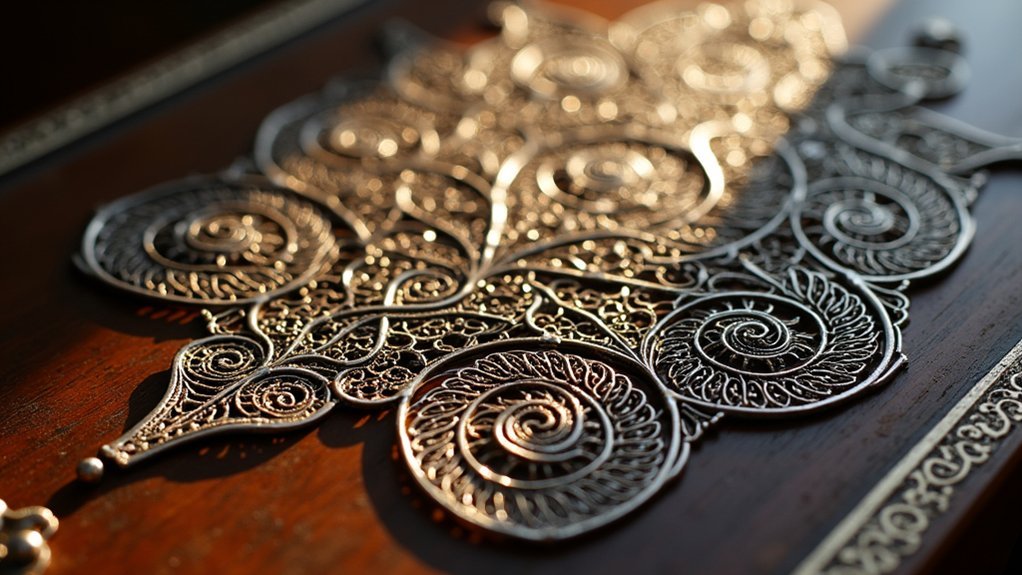The Mediterranean region developed three remarkable filigree techniques: Mesopotamian Telkari (3000 BCE), featuring delicate twisted gold and silver wires; Etruscan fusion, which combined filigree with granulation for complex patterns; and Moorish-Iberian craftsmanship, known for intricate geometric and floral motifs. These ancient methods created jewelry that served as both status symbols and protective amulets. The preservation of these techniques guarantees these cultural treasures continue to influence contemporary artisans worldwide.
Telkari: Ancient Mesopotamian Wire Artistry

While many ancient metalworking techniques have faded into obscurity, telkari stands as a representation of Mesopotamian ingenuity that has endured for five millennia. Dating back to 3000 BC, this intricate filigree technique involves twisting and plaiting fine gold and silver wires to create delicate, lace-like designs.
You’ll find evidence of telkari’s significance in archaeological treasures from the Royal Cemetery of Ur, where exquisite filigree beads adorned the elite, serving both as status symbols and protective amulets. The remarkable craftsmanship influenced Etruscan and Greek jewelry traditions, spreading throughout the Mediterranean.
Today, telkari continues as a vibrant cultural heritage, particularly in places like Cuttack, India, where skilled artisans maintain traditional methods using high-purity silver alloys, preserving this ancient Mesopotamian art form for future generations.
Etruscan Granulation and Filigree Fusion
The telkari techniques that flourished in Mesopotamia found a sophisticated evolution in the hands of Etruscan artisans, who created an artistic revolution by marrying filigree with granulation.
The ancient marriage of wire and granule transformed Mesopotamian metalwork into an Etruscan artistic language that redefined jewelry craftsmanship.
From the 8th to 3rd century BCE, they mastered the application of tiny metal granules alongside delicate wire work, producing Etruscan jewelry with unparalleled intricate designs.
You’ll notice their distinctive craftsmanship in three key innovations:
- Gold filigree settings enhanced with shimmering granulated patterns
- Advanced soldering techniques that enabled more complex assemblies
- Elaborate motifs including flowers, leaves, and geometric shapes
Their decorative artistry, emphasizing textured surfaces and dimensional depth, profoundly influenced Mediterranean cultures.
The Romans particularly embraced these techniques, adapting the Etruscan fusion of granulation and filigree into their own jewelry traditions, ensuring this sophisticated metalworking legacy continued throughout antiquity.
Moorish-Influenced Iberian Filigree Craftsmanship

Following the Etruscan innovations, a remarkable transformation of Mediterranean metalwork emerged during the Islamic rule of the Iberian Peninsula from the 8th to 15th centuries.
Moorish-influenced filigree craftsmanship introduced unprecedented intricacy through the masterful manipulation of silver and gold wires, creating jewelry pieces that seamlessly blend geometric patterns with floral motifs.
You’ll find the most exquisite examples from Toledo and Seville, where artisans perfected traditional techniques that reflected Islamic artistic sensibilities while developing a distinctly Iberian character.
This cultural heritage experienced a renaissance in the late 19th century when craftspeople revived historical designs.
Today’s artisans continue this legacy, producing contemporary works that honor the historical significance of Moorish-influenced filigree while ensuring these meticulous methods remain a living tradition rather than a forgotten art.
Frequently Asked Questions
Which City Is Famous for Filigree?
You’ll find several cities famous for filigree craftsmanship. Gondomar in Portugal, Cuttack in India, Malta, Mardin in Turkey, and Florence in Italy each have unique filigree traditions with distinctive techniques and cultural significance.
What Is the Difference Between Filigree and Cannetille?
You’ll notice filigree creates delicate openwork patterns with thin wires that allow light through, while cannetille uses coiled metal filaments forming raised, solid designs that add texture and dimension to jewelry pieces.
What Is a Royal Filigree?
Royal filigree is the highest-quality, intricate metalwork crafted for nobility using precious metals like gold and silver. You’ll recognize it by its exceptional craftsmanship and lavish designs that symbolize wealth and power.
Where Did the Filigree Pattern Come From?
You’ll find that filigree patterns originated in ancient Mesopotamia around 3000 BC. Craftsmen there first developed the technique using gold and silver wire, which they called telkari, before it spread worldwide.
In Summary
You’ve now explored three distinct Mediterranean filigree techniques that have shaped jewelry history. From Telkari’s intricate wirework originating in ancient Mesopotamia to the Etruscans’ masterful granulation methods and the geometric precision of Moorish-influenced Iberian designs, you can see how these traditions have endured. These techniques aren’t just historical curiosities—they’re living art forms that continue to inspire contemporary jewelry artisans worldwide.





Leave a Reply